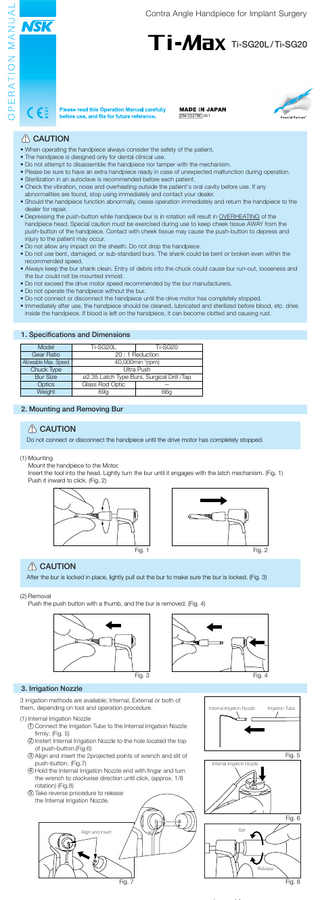NSK
Ti-Max Handpiece Contra Angle Operation Manual
2 Pages

Preview
Page 1
Contra Angle Handpiece for Implant Surgery
Ti-SG20L / Ti-SG20
OM-C0279E 001
CAUTION • When operating the handpiece always consider the safety of the patient. • The handpiece is designed only for dental clinical use. • Do not attempt to disassemble the handpiece nor tamper with the mechanism. • Please be sure to have an extra handpiece ready in case of unexpected malfunction during operation. • Sterilization in an autoclave is recommended before each patient. • Check the vibration, noise and overheating outside the patient's oral cavity before use. If any abnormalities are found, stop using immediately and contact your dealer. • Should the handpiece function abnormally, cease operation immediately and return the handpiece to the dealer for repair. • Depressing the push-button while handpiece bur is in rotation will result in OVERHEATING of the handpiece head. Special caution must be exercised during use to keep cheek tissue AWAY from the push-button of the handpiece. Contact with cheek tissue may cause the push-button to depress and injury to the patient may occur. • Do not allow any impact on the sheath. Do not drop the handpiece. • Do not use bent, damaged, or sub-standard burs. The shank could be bent or broken even within the recommended speed. • Always keep the bur shank clean. Entry of debris into the chuck could cause bur run-out, looseness and the bur could not be mounted inmost. • Do not exceed the drive motor speed recommended by the bur manufacturers. • Do not operate the handpiece without the bur. • Do not connect or disconnect the handpiece until the drive motor has completely stopped. • Immediately after use, the handpiece should be cleaned, lubricated and sterilized before blood, etc. dries inside the handpiece. If blood is left on the handpiece, it can become clotted and causing rust.
1. Specifications and Dimensions Model Gear Ratio Allowable Max. Speed Chuck Type Bur Size Optics Weight
Ti-SG20L Ti-SG20 20 : 1 Reduction 40,000min-1(rpm) Ultra Push ø2.35 Latch Type Burs, Surgical Drill /Tap Glass Rod Optic 69g 66g
2. Mounting and Removing Bur
CAUTION Do not connect or disconnect the handpiece until the drive motor has completely stopped. (1) Mounting Mount the handpiece to the Motor. Insert the tool into the head. Lightly turn the bur until it engages with the latch mechanism. (Fig. 1) Push it inward to click. (Fig. 2)
Fig. 1
Fig. 2
CAUTION After the bur is locked in place, lightly pull out the bur to make sure the bur is locked. (Fig. 3) (2) Removal Push the push button with a thumb, and the bur is removed. (Fig. 4)
Fig. 3
Fig. 4
3. Irrigation Nozzle 3 irrigation methods are available; Internal, External or both of them, depending on tool and operation procedure. (1) Internal Irrigation Nozzle 1 Connect the Irrigation Tube to the Internal Irrigation Nozzle firmly. (Fig. 5) 2 Instert Internal Irrigation Nozzle to the hole located the top of push-button.(Fig.6) 3 Align and insert the 2projected points of wrench and slit of push-button. (Fig.7) 4 Hold the Internal Irrigation Nozzle end with fingar and turn the wrench to clockwise direction until click. (approx. 1/8 rotation) (Fig.8) 5 Take reverse procedure to release the Internal Irrigation Nozzle.
Internal Irrigation Nozzle
Irrigation Tube
Fig. 5 Internal Irrigation Nozzle
Fig. 6 Set
Align and insert
Release
Fig. 7
Fig. 8
(2) External Irrigation Nozzle Connect the Irrigation Tube to the External Irrigation Nozzle firmly. (Fig. 9) (3) Internal and External Irrigation together Connect the ends of the Y-Connector to the Internal Irrigation Nozzle and External Irrigation Nozzles respectively as detailed in procedures (1) and (2). (Fig. 10) Irrigation Tube External Irrigation Nozzle
Irrigation Tube
Y-Connector
Fig. 9
Fig. 10
4. Lubrication Supply PANA SPRAY Plus / PANA SPRAY after each use and/or before each autoclaving. 1 Push E-type spray nozzle attachment over the spray nozzle until it firmly seats. 2 Shake the can vigorously to mix lubricant and propellant. 3 Insert the Nozzle in the rear of the handpiece. Spray the lubricant into the handpiece 2-3 times for 2-3 seconds each time. E-type Spray Nozzle
PANA SPRAY Plus / PANA SPRAY
Handpiece
PANA SPRAY Plus / PANA SPRAY
Fig. 11
CAUTION • Hold the handpiece and the spray can securely or the handpiece may eject from your hand due to the high pressure of the spray. • Repeat this lubrication until you see no foreign articles such as blood penetrated into the handpiece comes out. • Hold the spray can upright for spraying.
5. Cleaning and Sterilization This handpiece can be washed via Thermo Disinfector.
CAUTION Immediately after use, the handpiece should be cleaned, lubricated and sterilized before blood, etc. dries inside the handpiece. If blood is left on the handpiece, it can become clotted and causing rust. Steam autoclave is recommended. Sterilization is required first time you use and after each patient. Autoclave Procedure : 1 Scrub dirt and debris from the handpiece, and wipe clean with alcohol-immersed cotton swab or cloth. Do not use a wire brush. 2 Lubricate with the handpiece. Refer to 4. Lubrication. 3 Insert into an autoclave pouch. Seal the pouch. 4 Autoclavable up to max. 135˚C. ex.) Autoclave for 20 min. at 121˚C, or 15 min. at 132˚C. 5 Keep the handpiece in the autoclave pouch to keep it clean until you use it. Sterilization at 121˚C for more than 15 minutes is recommended by EN13060 or EN554.
CAUTION Do not wipe with, or clean or immerse in, high acid water or sterilizing solutions.
6. Cleaning the Glass Rod Optic (Ti-SG20L) Clean the glass rod optic with cotton swab soaked in alcohol.
CAUTION Do not use a sharp tool to clean the glass rod optic. It could damage the glass rod optic and decrease the light transmission. If it becomes dim, contact your dealer.
Cotton Swab
Glass Rod Optic
Fig. 12
’09.07.005 M